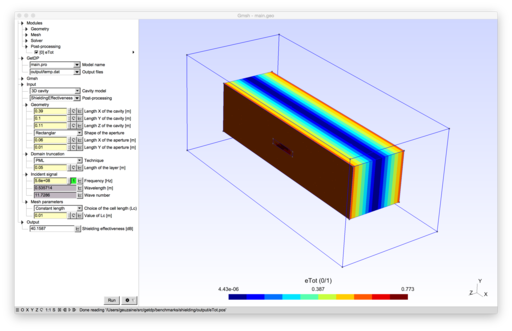Difference between revisions of "Shielding effectiveness"
(New onelab-getdp benchmark : shielding effectiveness) |
|||
| Line 3: | Line 3: | ||
{{mytexdefs}} | {{mytexdefs}} | ||
| − | == | + | == Introduction == |
| − | <ref name= Boubekeur201X /><ref name=Dawson1998 /><ref name=Ojeda2005 /> | + | The effectiveness of electromagnetic shields is evaluated in this example. Different academic cavities are considered. See e.g. <ref name= Boubekeur201X /><ref name=Dawson1998 /><ref name=Ojeda2005 />. |
| + | |||
| + | $\rightarrow$ To run the model, open '''main.pro''' with Gmsh. | ||
| + | |||
| + | == Shielding effectiveness == | ||
| + | |||
| + | In the time-harmonic context, the ability of a cavity to reduce a signal is quantified by the ''shielding effectiveness'', defined by | ||
| + | \begin{equation} | ||
| + | 20\:\log_{10} \left|\frac{E^{\text{inc}}}{E^{\text{trans}}}\right| \quad\quad [\text{dB}] | ||
| + | \end{equation} | ||
| + | where $E^{inc}$ and $E^{trans}$ and the amplitudes of the incident wave and the transmitted one, respectively. | ||
== References == | == References == | ||
| Line 11: | Line 21: | ||
<references> | <references> | ||
| − | <ref name= Boubekeur201X> M. Boubekeur, A. Kameni, L. Pichon, A. Modave and C. Geuzaine, [http://onlinelibrary.wiley.com/doi/10.1002/jnm.1968/abstract Analysis of transient scattering problems using a discontinuous Galerkin method: application to the shielding effectiveness of enclosures with heterogeneous walls]. International Journal of Numerical Modelling: Electronic Networks, Devices and Fields | + | <ref name= Boubekeur201X> M. Boubekeur, A. Kameni, L. Pichon, A. Modave and C. Geuzaine, [http://onlinelibrary.wiley.com/doi/10.1002/jnm.1968/abstract Analysis of transient scattering problems using a discontinuous Galerkin method: application to the shielding effectiveness of enclosures with heterogeneous walls]. International Journal of Numerical Modelling: Electronic Networks, Devices and Fields, 27(3), pp. 626-635, 2014. </ref> |
<ref name=Dawson1998> J. F. Dawson, M. D. Ganley, A. C. Marvin, S. J. Porter and D. W. P. Thomas, [http://ieeexplore.ieee.org/xpl/login.jsp?tp=&arnumber=709422&url=http%3A%2F%2Fieeexplore.ieee.org%2Fiel4%2F15%2F15395%2F00709422 Analytical Formulation for the Shielding Effectiveness of Enclosures with Apertures]. IEEE Transactions on Electromagnetic Compatibility, 40(3), pp. 240-248, 1998.</ref> | <ref name=Dawson1998> J. F. Dawson, M. D. Ganley, A. C. Marvin, S. J. Porter and D. W. P. Thomas, [http://ieeexplore.ieee.org/xpl/login.jsp?tp=&arnumber=709422&url=http%3A%2F%2Fieeexplore.ieee.org%2Fiel4%2F15%2F15395%2F00709422 Analytical Formulation for the Shielding Effectiveness of Enclosures with Apertures]. IEEE Transactions on Electromagnetic Compatibility, 40(3), pp. 240-248, 1998.</ref> | ||
Revision as of 17:03, 11 April 2014
|
2D and 3D models of cavities for electromagnetic shielding
|
 
|
|---|
|
Download model archive (shielding.zip) |
\(\renewcommand{\vec}[1]{\mathbf{#1}} \newcommand{\Grad}[1]{\mathbf{\text{grad}}\,{#1}} \newcommand{\Curl}[1]{\mathbf{\text{curl}}\,{#1}} \newcommand{\Div}[1]{\text{div}\,{#1}} \newcommand{\Real}[1]{\text{Re}({#1})} \newcommand{\Imag}[1]{\text{Im}({#1})} \newcommand{\pvec}[2]{{#1}\times{#2}} \newcommand{\psca}[2]{{#1}\cdot{#2}} \newcommand{\E}[1]{\,10^{#1}} \newcommand{\Ethree}{{\mathbb{E}^3}} \newcommand{\Etwo}{{\mathbb{E}^2}} \newcommand{\Units}[1]{[\mathrm{#1}]} \)
Introduction
The effectiveness of electromagnetic shields is evaluated in this example. Different academic cavities are considered. See e.g. [1][2][3].
$\rightarrow$ To run the model, open main.pro with Gmsh.
Shielding effectiveness
In the time-harmonic context, the ability of a cavity to reduce a signal is quantified by the shielding effectiveness, defined by \begin{equation} 20\:\log_{10} \left|\frac{E^{\text{inc}}}{E^{\text{trans}}}\right| \quad\quad [\text{dB}] \end{equation} where $E^{inc}$ and $E^{trans}$ and the amplitudes of the incident wave and the transmitted one, respectively.
References
- ↑ M. Boubekeur, A. Kameni, L. Pichon, A. Modave and C. Geuzaine, Analysis of transient scattering problems using a discontinuous Galerkin method: application to the shielding effectiveness of enclosures with heterogeneous walls. International Journal of Numerical Modelling: Electronic Networks, Devices and Fields, 27(3), pp. 626-635, 2014.
- ↑ J. F. Dawson, M. D. Ganley, A. C. Marvin, S. J. Porter and D. W. P. Thomas, Analytical Formulation for the Shielding Effectiveness of Enclosures with Apertures. IEEE Transactions on Electromagnetic Compatibility, 40(3), pp. 240-248, 1998.
- ↑ X. Ojeda and L. Pichon, Combining the Finite Element Method and a Padé Approximation for Scattering Analysis Application to Radiated Electromagnetic Compatibility Problems. Journal of Electromagnetic Waves and Applications, 19(40), pp. 1375-1390, 2005.
|
Model developed by A. Modave.
|

